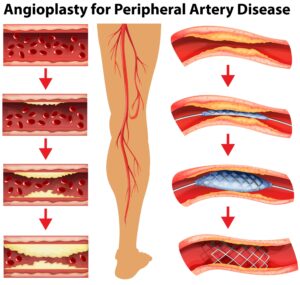Are you ready to embrace the benefits of walking? We know that maintaining a regular (physician approved) exercise program can help you slow the progression of vein disease, while also lowering your risk of experiencing associated complications, but we also know that it can be tough to get started.

Frequent exercise, like taking walks, can help manage the pain of PAD
To help you get motivated, our Texas Endovascular Team regularly shares Move it Monday fitness inspiration! If you like it what you see, incorporate the workout in to your routine! Not your jam? Come back another time for more motivation!
On the schedule this week: A Beginner’s Walking Schedule, courtesy of VeryWellFit.com: Before beginning, check your posture to make sure your chin is up, you’re standing straight, and you’re not leaning forward or backward while you move. Walk at an easy pace for a few minutes before speeding up. Wear supportive shoes and comfy clothing. You can do your walking outdoors, indoors, or on a treadmill.
In order to enjoy some of the benefits of walking, you actually have to get your body moving! Here's a four-week plan for moving more and helping your body enjoy the results.
Week 1: Start with a daily 15-minute walk at an easy pace. Walk five days the first week. You want to build a habit, so consistency is important. Spread out your rest days, such as making day 3 a rest day and day 6 a rest day.
Weekly total goal: 60 to 75 minutes.
Week 2: Add five minutes a day so you are walking for 20 minutes, five days a week. Or, you may wish to extend yourself more on some days, followed by a rest day.
Weekly total goal: 75 to 100 minutes.
Week 3: Add five minutes a day so you are walking for 25 minutes, five days a week.
Weekly total goal: 100 to 125 minutes.
Week 4: Add five minutes a day to walk for 30 minutes, five days a week.
Weekly total goal: 125 to 150 minutes.
Snags: If you find any week to be difficult, repeat that week rather than adding more time. Do this until you are able to progress comfortably.
Taking a walk is a great movement choice for everyone. But recent findings, presented at the European Society of Cardiology Congress, showed why it's even more important for older adults. Basically, they found that just one hour of walking a week reduces the risk of any form of death by 40%, for adults over the age of 85.
Here's what we learned. Researchers followed more than 7,000 over the age of 85 who joined the Korean National Health Screening Program. And even those who walked slowly, for at least 1 hour per week, enjoyed that 40% reduced risk for all-cause mortality. Plus, they reduced their risk of cardiovascular mortality by 39%, compared to adults who remained inactive. As a result, study author Moo-Nyun Jin, MD concluded, "Walking was linked with a lower likelihood of dying in older adults." And you can get those benefits whether you move slowly or vigorously.
Low impact workouts are a great choice for any one looking to increase your activity level. But, as vein specialists, we especially recommend walking to our PAD patients. That's because PAD pain often pops up when you walk, making this simple-yet-crucial task very difficult.
Why is walking so hard when you have PAD? It's because of atherosclerosis, which is when plaque builds up in your leg arteries. This plaque blocks oxygen and nutrients from getting to your legs when they fire up to get you moving. So, when you have PAD and you start moving, you may experience the pain of that oxygen deprivation.
But, even though PAD makes walking hurt, that very movement can help you manage PAD symptoms. The more you walk, the better your muscles learn to adapt to their limited blood supply. And, as your muscles adapt, you'll be able to walk for longer periods before that PAD pain pops up and slows you down. 
That's why walking programs like the one we just introduced can be helpful for PAD patients, helping improve your muscle strength as well as your ability to balance and complete your daily tasks. Also, as your calf muscles get stronger, your circulation may improve. And, if you dramatically improve your lifestyle habits as you embrace more movement, you may stop PAD progression as you research more permanent treatment options. (See the image at right for one PAD treatment option.)
Recently, a team of researchers from Hospital de Santo António in Porto, Portugal developed a mobile app to help PAD patients enjoy the benefits of walking. Called WalkingPad, the new app allows physicians to import walking prescriptions for their patients, and track the walks they take.
It's designed for use in the patient's home environment. Dr. Ivone Silva, one of the physicians at the developing hospital, explains that it offers a “participatory physical exercise program, carried out in a family environment. It is therefore more attractive, personalized, effective and of very low cost and risk when compared to a rehabilitation program carried out in the hospital.”
While the app is in its early stages of development, the developers hope to evolve the technology into a complete monitoring system for PAD patients. In the future, they hope it can function as a medical device that's able to analyze patients' walking patterns using artificial intelligence.
But, for now, it's simply about putting in the work and sticking to your walking program. Of course, your walking results won't be instant: you may need to stick to the program for as long as three months before seeing symptom improvements. Now, as always, check with your doctor before beginning any new exercise programs. If you have any questions about your ability to exercise with an endovascular condition, come in to our offices for a consultation with our Houston and Dallas area vein specialistsconsultation with our Houston and Dallas area vein specialistsconsultation with our Houston and Dallas area vein specialists, Dr. Fox, Dr. Hardee and Dr. Valenson.

Scheduling
Please contact our dedicated specialists to schedule a consultation today.
2024 Texas Endovascular. All rights reserved. Website Design by Healthcare Success